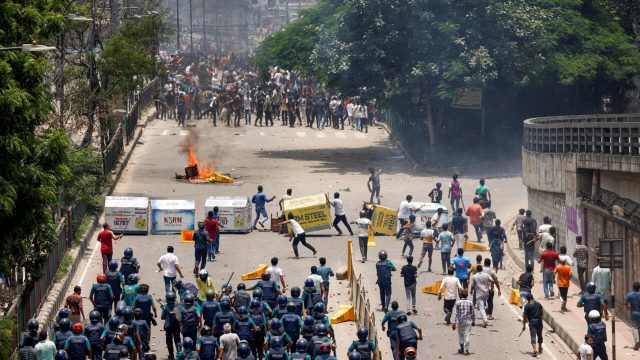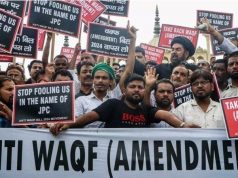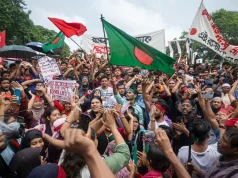
The recent student protests in Bangladesh have captured widespread attention, reflecting deep-seated frustrations among the youth toward the government and its policies. Sparked by the reinstatement of a controversial quota system, these protests have become a significant movement, highlighting broader issues of governance, corruption, and the struggle for justice.
The quota system in Bangladesh, introduced in 1972, has undergone numerous changes over the years. The latest version reserves 56% of civil service jobs for various groups: 30% for the descendants of freedom fighters from the 1971 Liberation War, 10% for women, 10% for marginalized districts, 5% for Indigenous populations, and 1% for people with disabilities. Civil service jobs are highly sought after due to their prestige, security, and benefits, making the quota system a contentious issue as it limits opportunities for those who do not fit into these categories.
In 2018, students from public universities across Bangladesh erupted in protest against the quota system, arguing that it undermined meritocracy. They were particularly critical of the 30% reserved for the descendants of freedom fighters. The intensity of these protests eventually forced the government to abolish the quota system, seemingly addressing the students’ demands.
However, on June 5, 2024, the High Court of Bangladesh reinstated the quota system, declaring its previous abolishment unconstitutional. This decision sparked immediate outrage among students, leading to widespread protests at Dhaka University and spreading nationwide. Initially, the government and ruling party politicians argued that the reinstatement was a judicial decision beyond their control. But a controversial remark by Prime Minister Sheikh Hasina on July 14, suggesting that the protesters preferred the descendants of Razakars (collaborators with Pakistani forces during the 1971 Liberation War) over freedom fighters, fueled further anger. Students took to the streets with chants like “Who am I? Who are You? Razakar, Razakar,” highlighting their discontent.
To contextualize the students’ anger and disappointment, it is crucial to understand why the term “Razakar” is so derogatory in Bangladesh. Razakars, meaning volunteers, were collaborators with the Pakistani military during the 1971 Liberation War. They are considered the worst traitors in the country’s history. Being labeled as Razakar is one of the gravest insults, evoking memories of betrayal and atrocity. Hasina’s remark implying that protesters preferred Razakars over freedom fighters deeply offended and angered the students, who viewed it as an unjust and inflammatory accusation.
The term Razakar has also been a point of contention in contemporary Bangladesh due to the execution of several Jamaat-e-Islami leaders accused of war crimes. These leaders, including Abdul Quader Molla (executed in 2013), Mohammad Kamaruzzaman (2015), Ali Ahsan Mohammad Mujahid (2015), Motiur Rahman Nizami (2016), and Mir Quasem Ali (2016), were tried and convicted, through a process that many have criticized as unjust and politically motivated. The most popular of these leaders, Allama Delwar Hossain Sayeedi, was sentenced to life imprisonment in 2013 but has been a significant figure whose trial and verdict stirred considerable controversy and debate within the country and among international observers. Critics argue that these trials were used to eliminate political opponents under the guise of seeking justice for wartime atrocities.
Following Hasina’s Razakar remarks, thousands of students from the Dhaka University dorms came out to the street and started shouting slogans which translates to “Who am I? Who are You?- Razakar, Razakar… Who said that? Who said that?- Autocrat. Autocrat.” However, the government and some media outlets distorted the students’ chants, focusing only on the first part and accusing them of identifying as Razakars. This misrepresentation further inflamed the situation, as politicians made harsh statements and issued threats based on this flawed interpretation.
The police crackdown on protesting students was marked by extreme brutality, as law enforcement agencies, often accompanied by members of the ruling party’s student wing, Bangladesh Chhatra League, used excessive force to disperse the crowds. Reports and videos circulated widely on social media, showing police using batons, tear gas, and water cannons against unarmed students. Many protesters, including women, were beaten and detained without cause. Some students sustained serious injuries from the violent confrontations. This harsh response by the authorities, aimed at quelling dissent, only served to intensify the anger and resolve of the student movement, highlighting the government’s heavy-handed approach to dealing with peaceful demonstrations. Despite these aggressive tactics, the protesters remained resolute, leading to a nationwide shutdown call on July 18.
In an unprecedented development, the protests extended to private universities, traditionally less involved in political violence. This expansion underscored the widespread discontent across different societal strata, as students from wealthier backgrounds joined the movement, blurring previous distinctions between public and private university activism.
Adding to the unique character of these protests, students and cultural groups created and disseminated revolutionary Bengali songs with a powerful spirit. These songs quickly went viral on digital platforms, amplifying the movement’s message. Classics like “Kandari Hushiyar” and other poems and songs by Kazi Nazrul Islam, Shukanta Bhattacharya, and Khudiram Boshu were edited with visuals of the protests, creating compelling content that resonated deeply with the public and highlighted the cultural and historical significance of the students’ demands.
On July 21, the Supreme Court of Bangladesh issued a verdict on the quota issue. The court reduced the freedom fighter quota from 30% to 5% and stated that the government could adjust this quota as necessary. The new distribution would be 93% on merit, 5% for freedom fighters, and 2% for others. While this decision appeared to favor the students, it raised questions about the court’s role in determining quotas, which is traditionally a parliamentary responsibility. Critics argue that the courts in Bangladesh often act as puppets of the government, with some even suggesting that judgments come directly from the Government’s offices.
Despite the court’s verdict, the students vowed to continue their protests until Prime Minister Sheikh Hasina apologized for the killings of young protesters and resigned. However, the confusing nature of the verdict has complicated their struggle. The government may have managed to alleviate some pressure, making it challenging for the students to sustain the momentum of their protests.
The involvement of the Chhatra League in violently suppressing dissent has further tainted the government’s image, fueling public outrage. The student protests in Bangladesh are no longer just about the quota system. They reflect a deeper, more pervasive dissatisfaction with the current political and social order. The government’s harsh response and refusal to engage in meaningful dialogue have only intensified the crisis, making it clear that a resolution requires addressing the broader grievances of the nation’s youth and general populace. The coming days will be crucial in determining whether the students can maintain their resolve and continue to push for change, or if the government’s tactics will succeed in quelling their movement.






Very good contents like your post.